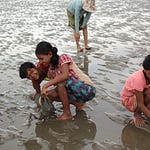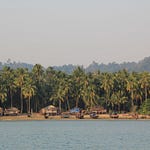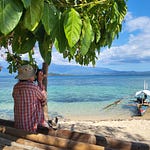KEY POINTS:
Lenovo’s Work for Humankind efforts to bring technology and opportunities for diversity to the conservation field
Efforts to improve sustainability in production & transportation in tech
Partnership with Historically Black College & University (HBCU) institutions
Developing a field experience project that responded to student needs
Contrasting tale of my sponsored-by-Pepsi high school
Importance of empowering people to access and enjoy nature
LINKS
More on the Lenovo partnership with Elizabeth City State University here and here
Black Girls Hike, an organization empowering young women of color in access to nature and advocacy
GirlTREK, an organization that works to inspire Black women to walk for health and enjoyment, while mobilizing efforts for advocacy
Brown People Camping, a social media initiative for greater diversity and social justice in the outdoors
Story by NPR on organizations like Black Girls Hike and GirlTREK
Ocean Discovery Institute in San Diego
INTRO
Hi, all! This is Conservation Realist, Episode 13. I am Dr. Tara Sayuri Whitty, and this podcast is a side project to share interesting and important ideas and stories in biodiversity conservation.
This episode is a continuation of Episode 12, where I spoke with students Aniya Martin and Angel Teagle about their experience in immersive field learning with Lenovo’s Work for Humankind initiative. As a refresher: Work for Humankind is a broad initiative with specific projects, including a partnership with the HBCU Elizabeth City State University to use technology and learning opportunities to empower diverse students and contribute to more diverse communities accessing nature. Aniya and Angel shared how positive and meaningful their time with this Lenovo project was, which certainly helped soothe any concerns I had about including this project in this podcast!
In this episode, I chat with Gerald Youngblood, the Chief Marketing Officer for Lenovo North America. I was curious to learn more about how projects like this actually come about – how are they developed, and where do they fit into a large global company’s operations and goals? This conversation is fairly brief, as I wanted to really focus more attention and time on what the students had to share.
What really stood out to me as particularly useful for how I think about conservation is how this Work for Humankind team really paid attention to feedback from the students about what kind of project would be most useful to them, as well as the understanding that longer-term partnerships are needed to amplify the impacts of short-term efforts. I think many of you might find this interesting in thinking creatively about possible partnerships – synergies – with private sector players for future projects.
I’m trying a new thing where I keep my introductions short, and then expand on my thoughts toward the end of the episodes. So, a clip from the song Green Touch by Soe Moe Thwin, Zyan Htet, and Min Min in Myanmar, and then the conversation!
TRANSCRIPT
T: Well, so a little brief background on me and the reason I'm even doing this is: I study basically how conservation works or doesn't work. And that applies to conservation on many different scales, both on like discrete projects (like how did we fail to save an animal?), but also something that's become increasingly important to me is how people can access the field of conservation. And that includes how diversity is addressed both in terms of who's being trained to enter this and similar fields, but also how people in the general public are able to access information and to kind of be exposed to the fruits of conservation. And I understand that, for example, access by Black people to national parks is one thing that was noted in the Lenovo Work for Humankind website as an issue that needed to be addressed.
I have very little patience for projects that claim to increase diversity without actually trying to get at the root causes of why diversity isn't better in the first place. So I was pleasantly, I wouldn't say “surprised,” but I was really happy to read about Lenovo's approach and also to hear from the students how the experience was for them. So, I'd love to just today learn a little more about what kind of went on behind the scenes and coming up with and formulating this project.
So, yeah, my first question, I guess, would be what was the driving motivation behind this project and its work related to increasing diversity in nature, in access to nature?
G: Yeah, I mean, I think it really starts with our global effort at Lenovo and the Work for Humankind program, which was actually a global program that was focused on providing the ability to work from anywhere and also having a positive impact on the places that you visit and that you work. And so we started with some remote work on Robeson Crusoe Island and being able to benefit on some conservation activities out there.
But for this particular program, we were looking in North America at what can we do here in the US and Canada to extend that same thought, but was particularly relevant to what we were dealing with here. And so you mentioned the National Park Service research that found that 6% of National Park visitors are Black and 77% are white. And so that's a shocking gap. And particularly in North Carolina, we saw a special opportunity, because this year is the Year of the Trail. And so it's a celebration of being outdoors, of national parks, of our impacts on the environment.
And we thought that with our relationships, existing relationships with our communities, including with Historically Black Colleges and Universities (HBCUs), that there was a great chance to bring this together in a way that made sense. And also, like you mentioned, could have a lasting impact because it's actually part of a program that was going on, you know, particularly at Elizabeth City State University with their emergency management degree program and some of their efforts.
So it made sense. But it also just feels like the right thing to do and a great place to start when there's focus on, you know, connecting with nature in North Carolina.
T: Yeah, that's great. And I'm curious, you mentioned that this relationship with Elizabeth City…College?
G: Elizabeth City State University.
T: All right…I keep getting it mixed up in my head and it is a bit early for me.
Elizabeth State University was a pre-existing relationship. So I'd love to hear a little bit more about that. How did that relationship start?
G: So we actually have a relationship at Lenovo with all of the 11 North Carolina HBCUs. And so a lot of times we'll, we'll lean on that network when we have an idea like this, to see which of those colleges and universities could leverage something like this. You know, so there's, there's timing, there's impact, there's the existing programs.
And so this, it just so happened that for the, the timing of the program and what the students were already studying, this seemed like the perfect fit for us to start this project.
T: That's great. I think one of the issues I see with kind of these band-aid diversity approaches is they forget that long-standing relationships with the groups you want to be impacting are so important. So how is the program itself shaped? Was there feedback provided from collaborators at Elizabeth City State University or any of the students, how was it shaped and kind of designed?
G: Yeah, so prior to the campaign, so we were able to actually interview some of the students and understand, you know, had they had any experience in nature? What were they interested in? And we were also at the same time looking at where were the locations that we felt like we could go to, you know, have an impact and find some synergies there between the programs and the interests of the students.
So, yeah, like one of the activities included was a hurricane response and cleanup. And that was with the U.S. Coast Guard on the Outer Banks. And one of the students actually who was volunteering on that leg was recently accepted into the Coast Guard. And so there were some synergies there. And so, yeah, there was a process beforehand just to, you know, assess interest.
And, you know, even with many of the students not having camped before and done some of those things, there was definitely interest in what we were going to go through and just interest in having a positive impact and the place you live, right, is a good connection for anyone. And it was relevant to what they were studying as well.
T: Yeah, that's fantastic. And I completely relate to those who hadn't camped before. I was in a similar situation until I had a similar opportunity, and it was certainly a valuable learning experience.
So I love that you talked with the students beforehand, kind of consulted with them to see what would be useful or interesting for them. Was there any other kind of care taken to ensure that this engagement would be as meaningful as possible? Do you guys have any way of monitoring the impact of this or is this kind of more of a, not informal, but are you just assuming it's going to work well and then just implementing it and seeing what's happening?
G: Not necessarily. I mean, I think really we thought that there would be long term elements also because of the focus that North Carolina has on this right now. So this is the largest celebration of trails and outdoor recreation in the state's history. And so it was an opportunity to capitalize on that momentum and know that this was the beginning of something, and not just a one-off program.
So when we look at, you know, was it successful or not? We're also thinking about, okay, can we go back to these places and see the impact? Is this something that would kick off even further development for us internally?
Because when we're looking at building out new technology, we also want to make sure that there's a positive connection for the communities that we work with as well. And so we've had some some groundbreaking technology that actually came out of programs like this, where we were working with local communities or indigenous communities.
So one of them being developing on our mobile side, we've been looking at indigenous languages. So the ability for like the Cherokee native language to be accessible through our mobile devices came from some work, not just in the US, but actually globally, around working with indigenous communities So we'll have continued engagement with these HBCUs and this one in particular too to see how we can build off this this program in the future.
T: That's great and just so you know, one of the things I asked the students was, you know, as great as this program sounds like it has been for you, what are things that you would change? And they're like, Lenovo has to do this more. You have to do it everywhere. So I think that's pretty resoundingly positive feedback that they enjoyed the program and found it beneficial.
G: Yeah, absolutely! Right. It's like you asked that question and we're like,
waiting for the response. But that's good to hear, right? I mean, I think in, in developing this whole like mountain to sea trail project is not the end of our efforts in this space. But if you think about that 6% versus 77% gap, like there's so much work to be done. And so we're going to continue continue to do that in a lot of different ways.
T: Okay, yeah, that's great. And I can really see… I have a personal interest in the disability justice space - my brother's a non-speaking autistic, he uses alternative communication. And there's so much promise for, well, especially remote work, right? That's something that the disability justice community had been fighting for long before the pandemic. And now that the pandemic has made people realize, oh, this is actually feasible. It's really great to hear that there are efforts at Lenovo to further facilitate ways in which people can engage with their workplaces, so to speak.
So I just wanted to say that it's really exciting on multiple levels to hear about this.
G: Yeah, I mean, you might be interested also in our work. We have a small business initiative and program called Evolve Small, where we worked with underrepresented founders, female founders, and to support their businesses in a lot of different ways. I won't go into all the details of that program. But one of the shining stars of that program is a company called 321 Coffee, who has coffee shops and roasting facility in North Carolina. But they specifically employ folks with intellectual and developmental differences.
And I think that path to employment as well, when you look at the unemployment number, like just just access to participate, right, and contribute is super important to, you know, to us at the company, but, you know, to our communities as well.
T: That's really good to hear. And I have, I guess my final question, and I don't know how detailed you might want to get with it: but I'm not so familiar with the space in which Lenovo and similar companies operate. And I hadn't previously really been aware of this kind of applied, community-focused impact side of companies like that.
I'd really love to hear from you a little bit more of how does the development, let's say of Lenovo product, how is that linked to (I assume) your team that’s working to find out how these products can conserve the world in diverse ways? Is there a kind of 2-way feedback going on? What is that process like?
G: Absolutely. If you think about our position, being a global technology company, being the number one PC company in the world as well, we have to be really thoughtful about the materials that we use, our supply chain, packaging, you know, all those things really factor into our impact on the like 180 plus communities that we live and work in.
And so there's a lot of thought that goes on in the company as to, you know, what can we do? So we've implemented things like bamboo packaging, and plastic free packaging, and a lot of instances to reduce that footprint. We lead in using recycled material. I actually have a laptop behind me that has like recycled magnesium or post-consumer plastics and things like that, that we integrate into our development process.
So, you know, there's a lot of thought there. But if you think about even broader, when I mentioned logistics, it's, you know, how do you get these products from point A to point B, and are there more sustainable ways to do that as well? And so we have some goals from a sustainability standpoint, that we're broadly communicating, where we're really trying to be thoughtful about bringing great technology to market, but doing it in a way that is more sensitive to the environment as well.
Then beyond that, to kind of go back to the programs that we're doing in the communities, we have an extremely diverse workforce. And we're fortunate because we get to work with a lot of different partners as well. And being able to bring our best selves to work is actually bringing that diverse viewpoint that reflects our customer base as well. So we're always looking for opportunities where we can bring our expertise on the technology side and have that be a gateway to, you know, breaking down barriers in these experiences.
You know, I can say as a minority person in the tech space as well, that I found a really great environment internally at Lenovo. And as a marketer, I want to make sure that we are showcasing that externally as well in a way that's like very authentic to the culture of the company.
T: Okay, that's that's fantastic to think about. And I really hadn't occurred to me that companies such as Lenovo would have a whole kind of aspect to their operations like this. And I actually do have a Lenovo computer that I'm sitting in front of right now.
Well, Gerald, we kind of blazed through all these questions. And I really learned a lot from your answers. I really appreciated speaking with you and learning more about this. I don't know if there's anything else you wanted to say about this work or anything related to that.
G: No, I mean, just it was a pleasure for us to be able to work with the students and see them light up with some of the new experiences that they got to see as part of this program.
I'd also say that like in the U.S. and Canada, we've partnered with BirdLife International to create really cool camper vans that are exploring the recording of bird songs so that we can actually add to and help their conservation efforts and get a better idea of the different indigenous species as well.
So there's a lot of stuff going on. We're doing things all over the world to really support efforts of trying to connect people with the environment and using technology in a positive way. So I really appreciate your time and the time of your audience to listen. And if anybody wants to get involved, they can check out lenovo.com and see what else we're working on and contribute any way that they see fit! So yeah, thank you.
T: Great. Thank you so much, Gerald. It was a pleasure to chat!
CLOSING THOUGHTS
Maybe some of you think it’s a little odd that these episodes feature a corporate project. I mean, as I said in Episode 12, I thought it was a little odd, too! But I really enjoyed learning from Aniya, Angel, and Gerald about work that I would have otherwise not known about, and it really stimulated my thinking about education and training as well as potential for partnerships with the private sector.
As someone who has learned to be… let’s say, mindfully skeptical?... of large NGOs and highly publicized international initiatives that don’t have meaningful links to on-the-ground action, where there’s a lot of style over substance, I am certainly even more skeptical of corporate efforts “for good.” There is a LOT of greenwashing, a lot of lip service to Diversity and Equity and Inclusion, a lot of “hey, we’re doing this optically generous thing over here, so don’t pay too much attention to the negative impacts we’re having over there.”
Even where genuine good intentions exist somewhere in the genesis of such efforts, they are often so enmeshed with artifice and distraction from serious questions about corporate behavior. My response to the sentimental ads put out about the social or environmental good that companies claim to do is often an eyeroll plus some profanity.
But I really did enjoy talking with Gerald, Angel, and Aniya, and learning that there are initiatives that – despite the corporate context in which they exist – actually care about having a positive impact, and actually succeed in doing so.
In contrast: my high school, a public school in California, was a Pepsi high school. I didn’t realize this was strange or even mildly dystopian until I went to college and mentioned this to other students there. Our school – Poway High School – was largely sponsored by Pepsi. Our track invitational (a large track & field event that we hosted) was the “Pepsi-Poway Invitational”, and our track hurdles had Pepsi logos on them. So, this would have been fine – great! – in theory, only this sponsorship also came with insisting that our school stocked Pepsi-brand vending machines, and that our pep rallies had advertisements promoting Pepsi products. It’s not like high schoolers are the most health-conscious demographic, but still, it’s not the most socially responsible thing to do – certainly not the truly philanthropic thing to do – to push your unhealthy products on youths where their options for other beverages are limited.
Anyway. I wanted to also touch on the statistic on access to national parks in the US, with 77% of park visitors being white and 6% being Black. A quick Google for the most recent census information shows that 13.6% of the US population is Black, while 75.8% is white. So, white people are slightly overrepresented in national park visitors, while Black people are underrepresented. Actually, an older NPR article on this research entitles their graph showing these data “National Park Visitors More White Than U.S.” Note that their figure – shared in the transcript – is based on 2008-2009 census and visitor information. According to that study, Hispanic and Asian people are also underrepresented as park visitors, while Native Americans were only slightly underrepresented.

I haven’t had the time to delve more into the more recent reports used by Lenovo, nor other research papers on this topic of national park visitation. I can say that I’ve volunteered, in the past, with efforts to help urban, underserved communities in San Diego access the ocean through snorkeling events, and it’s remarkable to see how much those visits – often the first visit for many of the kids – spark amazement and joy. San Diego is famous for its beaches, but it’s also not easy for many San Diego residents to even get to those beaches. Unfortunately, one of those organizations started taking kids from more privileged families, and it just wasn’t the same taking out students who had already been SCUBA diving during family vacations in the tropics (way before I’d ever had a chance to SCUBA myself).
Access to nature is not as simple as just “getting out there.” Is there transportation? Is there even an awareness of what is out there, what is worth visiting? Is there a sense of security in what the experience will be like, a sense of familiarity with whatever equipment or supplies or activities you need to feel okay going on the trail or in the water? I’ve included some links in the transcript for organizations who work along these lines.
Such experiences can be the spark to someone’s lifelong journey in enjoying nature, in finding health and mental or emotional benefits from nature, in discovering confidence in their own abilities and skills, in pursuing education and career pathways to support sustainability. As you heard from Angel and Aniya, even as students who have already chosen a major and are almost done with their undergraduate education, their opportunity for immersion through the Lenovo partnership made a meaningful contribution to their confidence, skills, and perspectives.
Thank you to Gerald, Aniya, and Angel for their time, as well as the team at NP Strategy for coordinating these chats. Next episode will be a journey to the west coast of Africa, where we learn about a fantastic organization doing work on marine megafauna out there! Yes, back to the large marine animals!
Thanks for listening, and take care!














Share this post